Petersburg Railroad
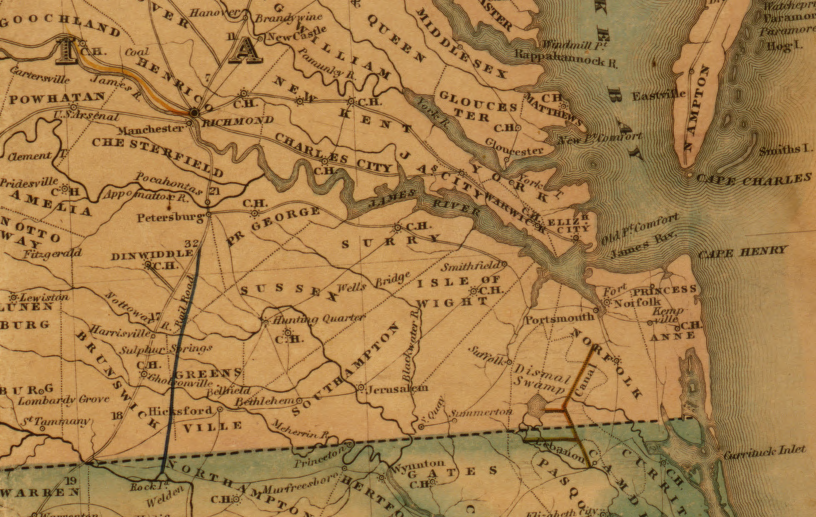
the Petersburg Railroad was built to draw Roanoke River trade to Petersburg, competing with the Dismal Swamp Canal taking trade to Norfolk
Source: Library of Congress, Map of the United States compiled from the latest and most accurate surveys by Amos Lay (1834)
The Petersburg and Roanoke Railroad was chartered by the General Assembly in 1830. It was the second railroad to receive a charter in Virginia, after the Chesterfield Railroad in 1828.
The Petersburg and Roanoke Railroad did not focus on generating revenues from hauling passengers. Instead, it sought to make a profit by reducing the costs and delays of freight transportation between the Roanoke River and the port at Petersburg.
Boats floating down the Roanoke River past the Petersburg and Roanoke Railroad reached the Albemarle and Pamlico Sound. Freight destined for the more numerous ships sailing through the Chesapeake Bay had to be transported through the Dismal Swamp Canal to Portsmouth and Norfolk. The docks at Petersburg on the Appomattox River provided a valuable connection to the ocean-going ships that entered the Chesapeake Bay, so the Petersburg Railroad focused on offering a short 62-mile path to the Chesapeake Bay watershed than the Dismal Swamp Canal.
The first trains ran on partially-completed track in 1832. The full line between Petersburg-Weldon, North Carolina on the Roanoke River was completed in 1833.1
Hampton Roads members of the General Assembly sought to block the state legislature from chartering the railroad. Better transportation infrastructure between Petersburg and the Roanoke River would help Petersburg gain business, traffic which otherwise would go via the Dismal Swamp Canal to Hampton Roads ports. The Hampton Roads delegation's efforts failed, and a charter for the Petersburg Railroad was granted on February 10, 1830.
The Hampton Roads ports exported tobacco and cotton to other cities. In contrast, Richmond and Petersburg had factories to process the raw agricultural materials into manufactured products, using waterpower available at the Fall Line. The Petersburg Railroad would help those two manufacturing cities grow.2
Farmers in the Roanoke River watershed could earn higher profits by selling crops at Petersburg, compared to sending cargo on bateaux over the Fall Line at Weldon. Boats floating downstream would end up at the mouth of the Chowan River, but there was no major port there.
In the 1700's, natural shifting of the sands closed the navigable inlets through the northern barrier islands at Currituck, Roanoke, and Hatteras. After Roanoke Inlet closed between 1792-1798, trans-Atlantic ships could access the Albemarle Sound only via Ocracoke Inlet. Portsmouth and Norfolk, with access to the Chesapeake Bay, were the best place for North Carolina farmers to sell their crops.3
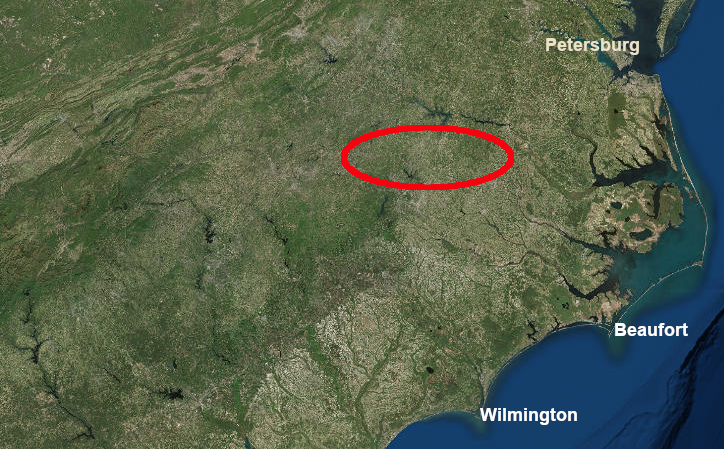
farmers in the northern North Carolina Piedmont (red circle) preferred transporting crops to Petersburg vs. the North Carolina ports of Beaufort and Wilmington
Source: ESRI, ArcGIS Online
The first major transportation project designed to divert North Carolina trade to a Virginia port was the Dismal Swamp Canal, built in 1793-1805. Crops grown in the Roanoke River watershed were loaded on batteaux and floated past Weldon. They traveled through the canal to the two Virginia ports, Portsmouth and Norfolk on the Elizabeth River.
The Petersburg Railroad was designed as an alternative to shipping via the Dismal Swamp Canal, or carting material in wagons over muddy roads to the head of navigation on the Fall Line. The railroad was not designed to help business grow in Portsmouth and Norfolk.
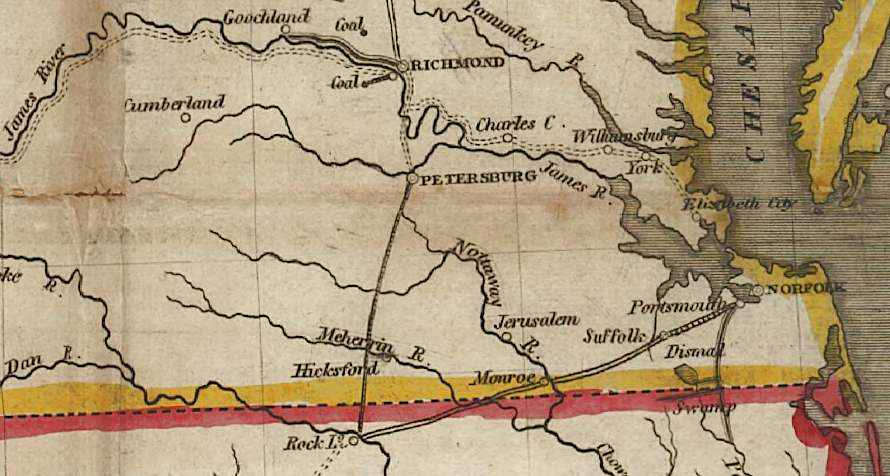
the Petersburg Railroad competed with the Portsmouth and Roanoke Railroad in 1834
Source: Library of Congress, Map of the railroads and canals, finished, unfinished, and in contemplation, in the United States (1834)
Petersburg merchants considered those cities as competitors, not as partners drawing North Carolina trade to Virginia. Petersburg viewed the ports in Hampton Roads as rivals in the shipping business.
In the 1830's, unlike today, trans-Atlantic ships could navigate up the James River shipping channel to the mouth of the Appomattox River. Petersburg business and political leaders wanted those ships to sail past the mouth of the Elizabeth River, bypassing Portsmouth and Norfolk.
Ships had to spend an extra day getting to the wharves at Petersburg, since Portsmouth and Norfolk were closer to the mouth of the Chesapeake Bay. Somehow, Petersburg merchants needed to make it worth the extra time for ships to sail up the James River.
The railroad between Petersburg and the Roanoke River was the solution. As a bonus, it would divert trade away from the Dismal Swamp Canal and reduce business in the rival ports of Hampton Roads. Attracting more cotton, tobacco, and other farm products to Petersburg, while reducing the volume sent via the Dismal Swamp Canal, would convince more ship captains to bypass Norfolk/Portsmouth.
Ideally, a railroad would create a positive feedback loop that would benefit Petersburg and hamstring its competitors.
Getting more captains to sail upstream to the mouth of the Appomattox River would lower shipping costs at Petersburg. More ships would create more competition. Faster delivery to customers in New York or Europe would result in faster payments. Lower transportation costs and faster payments would get farmers to send even more agricultural products to Petersburg.
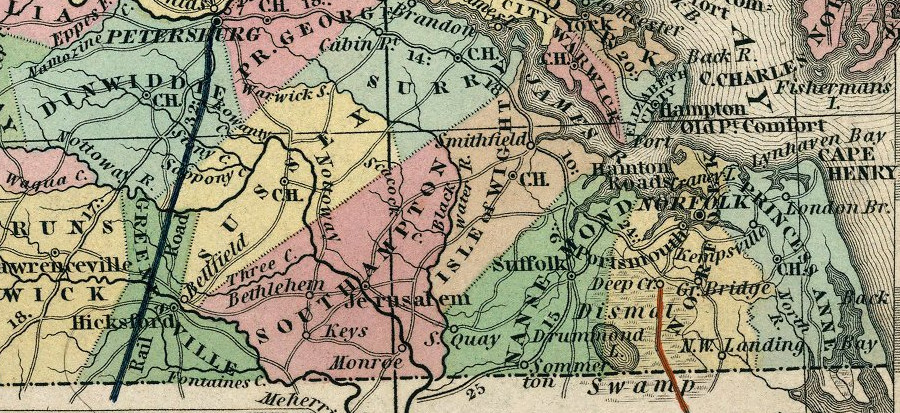
the Petersburg Railroad was constructed almost 30 years after the Dismal Swamp Canal (brown line)
Source: David Rumsey Historical Map Collection, Map of the United States compiled from the latest and most accurate surveys by Amos Lay (by Henry S. Tanner, 1833)
The competition between Virginia ports and the sectional conflict within Virginia was largely irrelevant to North Carolina farmers. Petersburg and Portsmouth/Norfolk both offered the essential service - access to ships moving through the Chesapeake Bay, as opposed to Albemarle Sound.
There was a similar sectional conflict within North Carolina. The port cities of Beaufort and Wilmington, on the southeastern edge of North Carolina, wanted to limit trade with Virginia and steer North Carolina farm products to North Carolina ports.
However, North Carolina farmers west of Raleigh and near the Virginia border could make a better profit doing business at Petersburg. A railroad to a North Carolina port might be beneficial, but a railroad to Petersburg would make farmland in the Piedmont even more valuable. Members elected to the North Carolina legislature struggled with proposals to approve transportation projects which would divert trade to Virginia ports.
The Petersburg Railroad was seen by the residents of Wilmington as a threat. They sought to block the North Carolina legislature from supporting more railroads that would connect to the Petersburg Railroad. Wilmington was North Carolina's main port, and the city feared diversion of trade to a port in Virginia would limit local economic growth.
The Wilmington and Raleigh Railroad was originally intended to connect the port of Wilmington with the Raleigh, in the interior of North Carolina. The "hinterland" was expected to send freight to the coast for shipment to Northern states or Europe. That would boost business in Wilmington.
When stock sales in the Raleigh area lagged, the railroad investors altered the inland destination to Weldon and reached there in 1841. Financial suport was stronger there, and the Wilmington and Raleigh Railroad could connect with the Petersburg Railroad as well as the Roanoke River Canal bypassing the Fall Line rapids.4
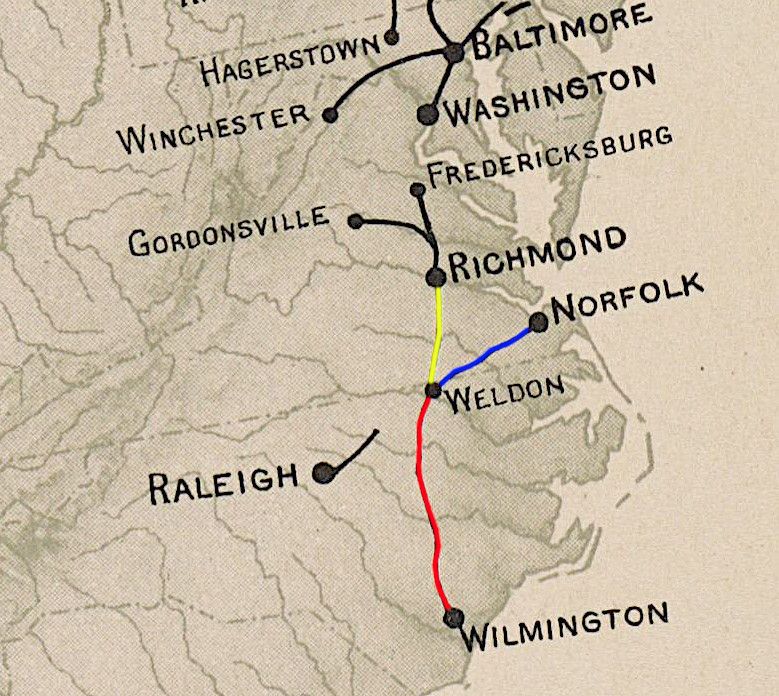
the Petersburg Railroad (yellow) reached Weldon in 1833, the Portsmouth and Roanoke Railroad (blue) in 1836, and the Wilmington and Raleigh Railroad (red) in 1841
Source: Atlas of the Historical Geography of the United States, Railroads in Operation, 1840 (by Charles O. Paullin, John K. Wright, 1932)
The change from Raleigh to Weldon was not welcomed by those merchants in Wilmington who benefitted from warehouse and steamship operations. In anticipation of the revision in 1834, the People's Press and Wilmington Advertiser published this complaint:5
- We object to the proposition to construct the first rail road, from the southern boundary to form a connection with those from Petersburg and Norfolk. Such a road would be intersected by every road, river and canal conveying produce from the interior; and this produce would consequently go to Petersburg or Norfolk.
- The current of trade, thus firmly established could never be diverted, and the interior of the State would become tributary to Virginia, and the whole sea-board abandoned to utter ruin.
In 1855, the Wilmington and Raleigh Railroad finally changed its name to the Wilmington and Weldon Railroad.6
Weldon evolved into a transportation hub with a significant railroad connection to Portsmouth, in addition to the traditional batteaux and steamboat traffic on the Roanoke River, after the Virginia and North Carolina legislatures ended up chartering the Portsmouth and Roanoke Railroad. Long before the railroads arrived, Weldon had become a key node in the transportation network between the interior and the seacoast ports.
That location was chosen as the railroad connection to the Roanoke River because of the physical geography. Rapids on the Fall Line there made it risky for batteaux to carry cargo further downstream. Hogsheads of tobacco, barrels of wheat and corn, and other products from as far upstream as Halifax and Campbell counties in Virginia were offloaded at the upper end of the rapids. After being carted nine miles downstream, cargo was reloaded onto boats that floated down the rest of the Roanoke River, into Albemarle Sound, up the Pasquotank River, and through the Dismal Swamp Canal to Portsmouth and Norfolk.
The Roanoke Navigation Company, chartered by North Carolina in 1812 and funded by Norfolk merchants, "improved" the river channel upstream of Weldon. Workers removed snags, blasted the rocks obstructing travel through rapids, and dredged shallow shoals. By 1834, the Roanoke Navigation Company completed a nine-mile long canal that completely bypassed the rapids between Wilkins Ferry (Gaston) and Weldon.7
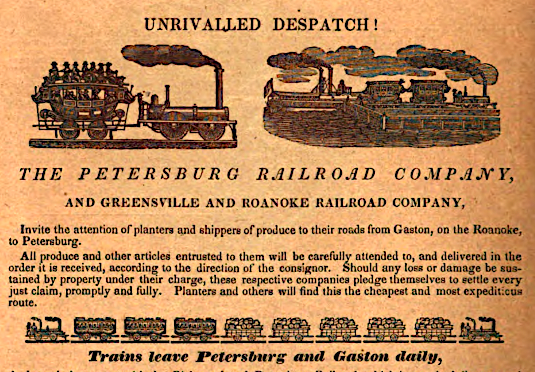
the Petersburg Railroad connection to the Greensville and Roanoke Railroad helped compete against the Portsmouth and Roanoke Railroad
Source: HathiTrust, Farmers' Register (July 1838, p.256)
The Petersburg Railroad track was completed in 1833 south to Blakely Landing, at the downstream end of the Roanoke Canal.
The railroad had hoped to find a partner to offset some of the costs in building an expensive bridge across the Roanoke River. Instead, the investors in the Weldon Toll Bridge chose to partner with the investors in the Portsmouth and Roanoke Railroad. That railroad laid tracks on a widened Weldon Toll Bridge to reach the town of Weldon on the south bank of the Roanoke River, and initially blocked the Petersburg Railroad from building its own bridge.
The Petersburg Railroad ended up building initially to the north bank of the Roanoke River at Blakely Landing. That site was south of the developing community of Garysburgh (which had an "h" in its name originally). Stopping at Blakely Landing made freight operations less efficient. Batteaux had to float cargo across the river from the southern end of the Roanoke River Canal to Blakely Landing, in order to load the Petersburg Railroad cars.
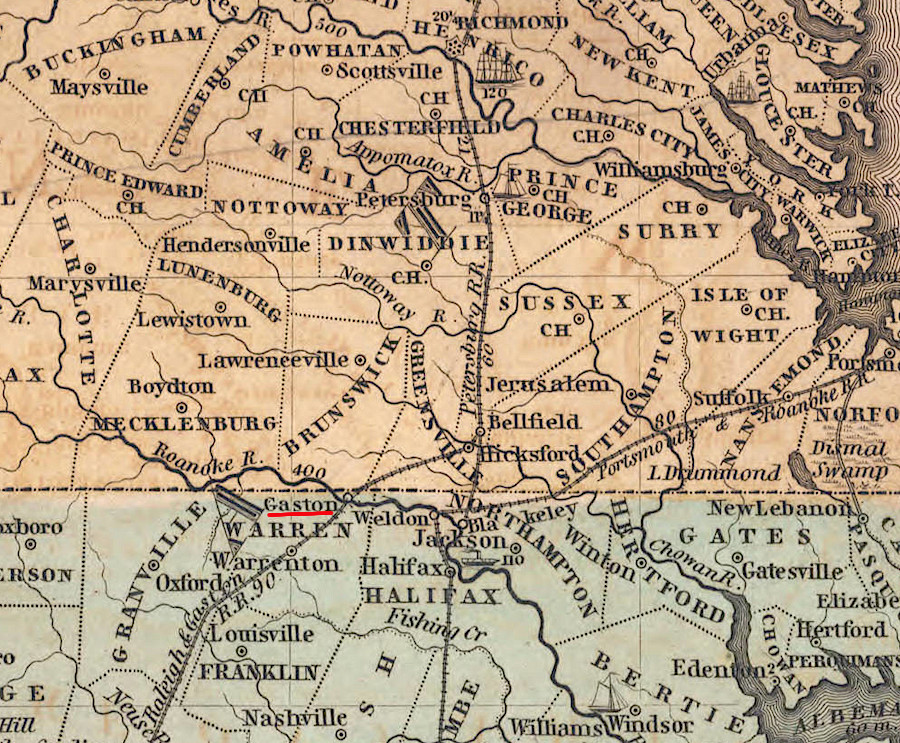
the Petersburg Railroad connected to the Raleigh and Gaston Railroad at Gaston, upstream of Weldon
Source: University of North Carolina, Map of the Middle States Designed to Accompany Smith's Geography for Schools (by Daniel Burgess and Roswell C. Smith, 1841)
The Portsmouth and Roanoke Railroad purchased the Weldon Toll Bridge in 1838. Cotton, tobacco, and other freight going on the Portsmouth and Roanoke Railroad ended up at wharves in Portsmouth on the Elizabeth River, not at wharves in Petersburg on the Appomattox River.
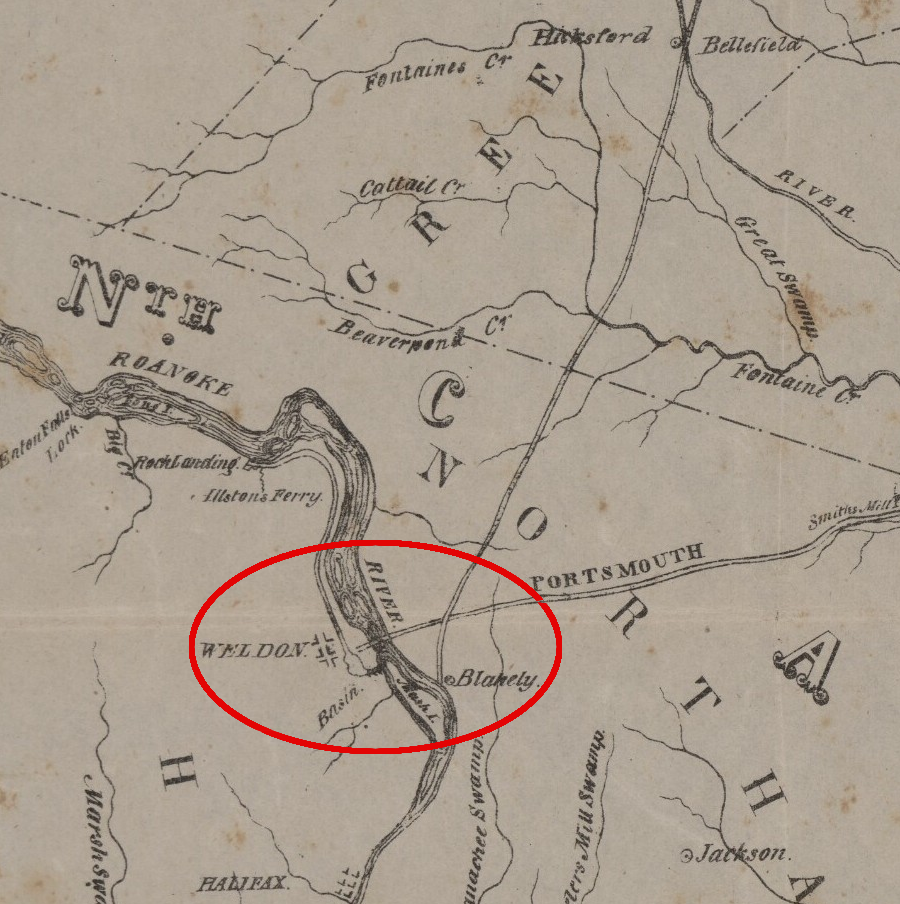
the Portsmouth and Roanoke Railroad built a bridge across the Roanoke River to Weldon in 1837, three years before the Petersburg Railroad
Source: University of Virginia Library, Plan of the Portsmouth & Roanoke Rail-Road and Trace of the Petersburg Rail Road (by Thos. H. Williamson, c.1835-1840)
The Petersburg Railroad's response was to build the 18-mile Greensville and Roanoke Railroad in 1837. The Greensville and Roanoke Railroad linked Hicksford (later called Emporia) on the Meherrin River to Wilkins Ferry. It connected to the upstream end of the Roanoke River Canal, above the Fall Line rapids.
Wilkins Ferry was renamed Gaston, and is now known as Thelma, North Carolina. Modern Gaston is located on the northern bank of the Roanoke River, while the "original" Gaston (Wilkins Ferry) was on the southern bank.
Investors in the Petersburg Railroad funded the Greensville and Roanoke Railroad. It allowed them to intercept batteaux on the Roanoke River before they floated through the Roanoke River Canal and then shifted freight to the Portsmouth and Roanoke Railroad at Weldon. The Greensville and Roanoke Railroad transported cargo north to the Petersburg Railroad and then to Petersburg on the Appomattox River, diverting trade away from Portsmouth on the Elizabeth River. The diversion was the economic equivalent of "stream piracy."8
Investors in Petersburg also supported construction of the Raleigh and Gaston Railroad, though that line was entirely within North Carolina. The Raleigh and Gaston Railroad was authorized to build a bridge across the Roanoke River at Wilkins Ferry (Gaston), at the southern end of the Greensville and Roanoke Railroad. The railroad would provide a southern link to Raleigh from Petersburg.
Construction material was brought from Petersburg via the Greensville and Roanoke Railroad. Iron straps, which were nailed to the tops of wooden stringers to make the first rails, were shipped to City Point. It was transported down the Petersburg Railroad to Hicksford, then via the Greensville and Roanoke Railroad to the Roanoke River. During its first year, operations and equipment on the Raleigh and Gaston Railroad were handled by the Petersburg Railroad.
The first Raleigh and Gaston Railroad construction, started in late 1836, was the bridge across the Roanoke River. Construction to the south reached Ridgeway in 1838, and finally Raleigh in 1840.
The Raleigh and Gaston Railroad funneled traffic east from Raleigh 85 miles to the Roanoke River. From there, the Greensville and Roanoke Railroad could take it on to Hicksford, and the Petersburg Railroad could take it north to the port city on the Appomattox River.
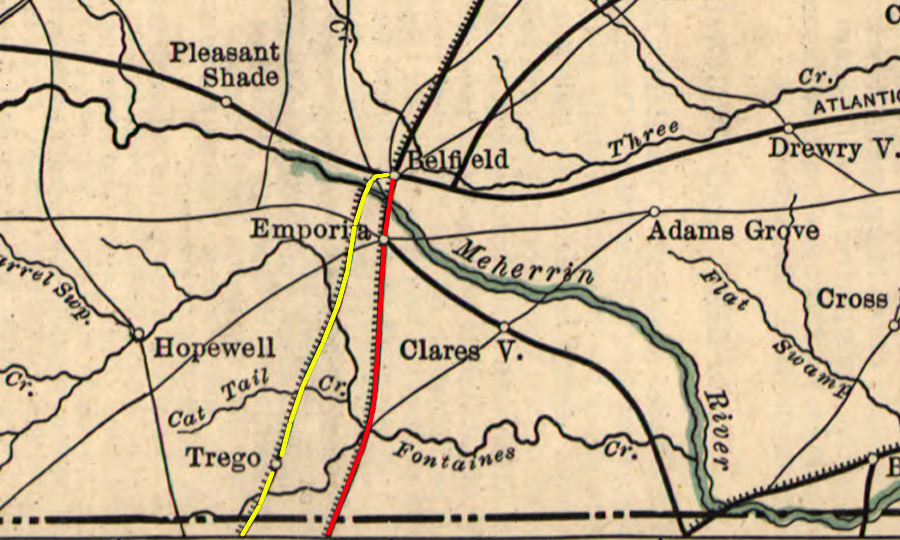
the Greensville and Roanoke Railroad (yellow) linked Hickford to Gaston, while the Petersburg Railroad (red) linked to the Roanoke River further downstream at Weldon
Source: Library of Congress, Map showing the location of battle fields of Virginia (by Chesapeake and Ohio Railway Company, 1895)
The Greensville and Roanoke Railroad was merged into the Petersburg Railroad in 1852. The bridge over the Roanoke River was destroyed by Confederate forces in April, 1865 at the end of the Civil War. The bridge was never rebuilt, and the track of the Greensville and Roanoke Railroad between Hicksford and Gaston was abandoned in 1874.9
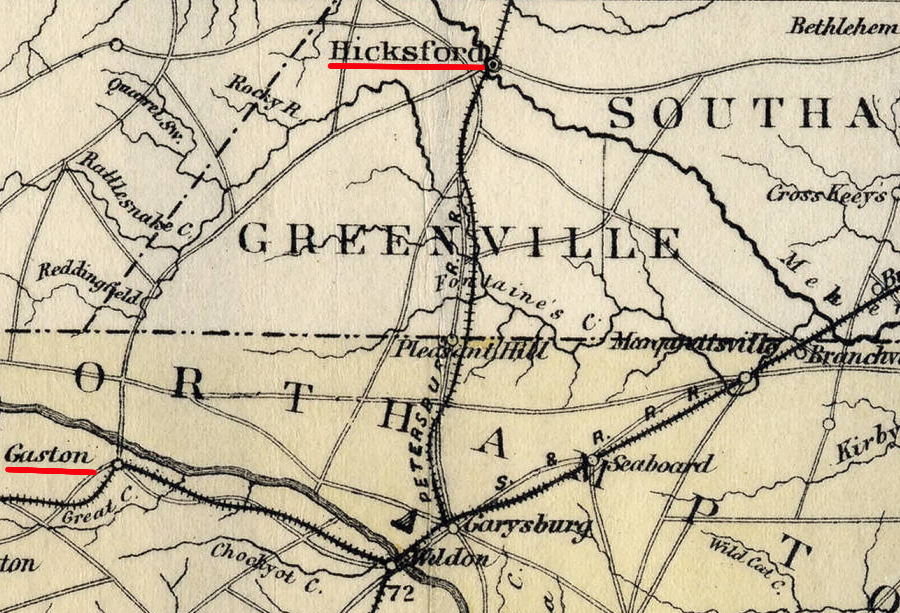
the Greensville and Roanoke Railroad track between Hicksford and Gaston was abandoned in 1874, and does not appear on this 1882 map
Source: University of North Carolina, Map of North Carolina (by Washington C. Kerr, 1882)
To compete with the Portsmouth and Roanoke Railroad, the Petersburg Railroad built a new rail corridor via the Raleigh and Gaston Railroad and the Greensville and Roanoke Railroad. In 1840 the Petersburg Railroad managed to build its own bridge at Weldon, crossing the Roanoke River.
The Petersburg Railroad also tried to destroy its rival, the Portsmouth and Roanoke Railroad. It organized a partnership with the Richmond and Petersburg Railroad and with the Richmond, Fredericksburg and Potomac Railroad to create an "inland" route which avoided the Hampton Roads ports. The allied railroads cut their fares in half. That reduced their revenues dramatically, but forced the Portsmouth and Roanoke Railroad to reduce its fares so low that the rival line would end up in bankruptcy.
Cutting revenues so low ended up being a recipe for financial disaster for all the railroads involved. They needed more, not less income to maintain and upgrade their quickly-built infrastructure. The initial tracks had been constructed cheaply and required extensive maintenance, and in places upgrades. The discounted rates severely reduced income that was badly needed to stabilize the fledgling railroads.
In 1842 the Petersburg Railroad told its largest stockholder, the state of Virginia, that no dividend would be paid that year:10
- I must inform you that the efforts of the Portsmouth Company [the Portsmouth and Roanoke Railroad] to divert our trade from us continue as active as ever. We no sooner lowered our rates of transportation last summer than they reduced theirs below ours, and it is probable we shall have to lower again.
By 1843 the Petersburg Railroad used its retained earnings to fund replacement of most of its initial strap iron rails. The old wooden ties, with a strip of iron nailed to the top, were replaced with heavier heavy T-iron rails imported from England. The company declined to order its rails from unproven Virginia iron furnaces, even though the initial cost might have been lower.
Due to the rate war, the Portsmouth and Roanoke Railroad was forced to borrow money in order to stay in operation. In 1843, the Petersburg Railroad acquired enough of its rival's debt to claim that it owned the track of the Portsmouth and Roanoke Railroad in North Carolina.
In a brazen assault, a crew from the Petersburg Railroad tore up the track of the Portsmouth and Roanoke Railroad near Weldon. In response, Portsmouth officials sent their own work gang to repel the attack and replace the track.
The North Carolina Supreme Court finally determined that the Petersburg Railroad was the legal owner of the track, and had the legal right to destroy their railroad. Traffic stayed interrupted until 1846, when the Virginia Board of Public Works bought the Portsmouth and Roanoke Railroad at auction and restarted the company as the Seaboard & Roanoke Railroad.
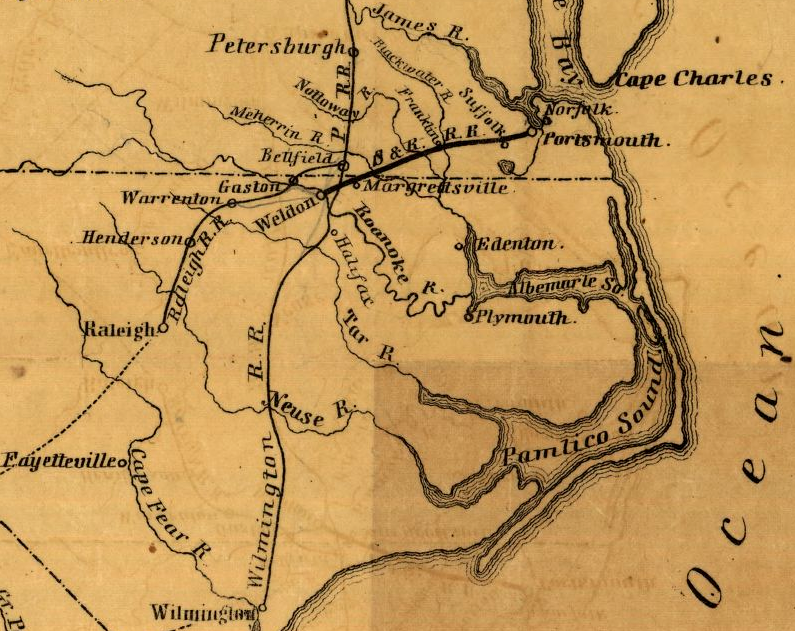
the Petersburg Railroad forced the Portsmouth and Roanoke Railroad into bankruptcy, but it reorganized as the Seaboard & Roanoke Railroad in 1846
Source: Library of Congress -
Map of the Seaboard & Roanoke Railroad from Portsmouth, Va. to Weldon, N.C. showing its connection with railroad & steamboat routes (1847)
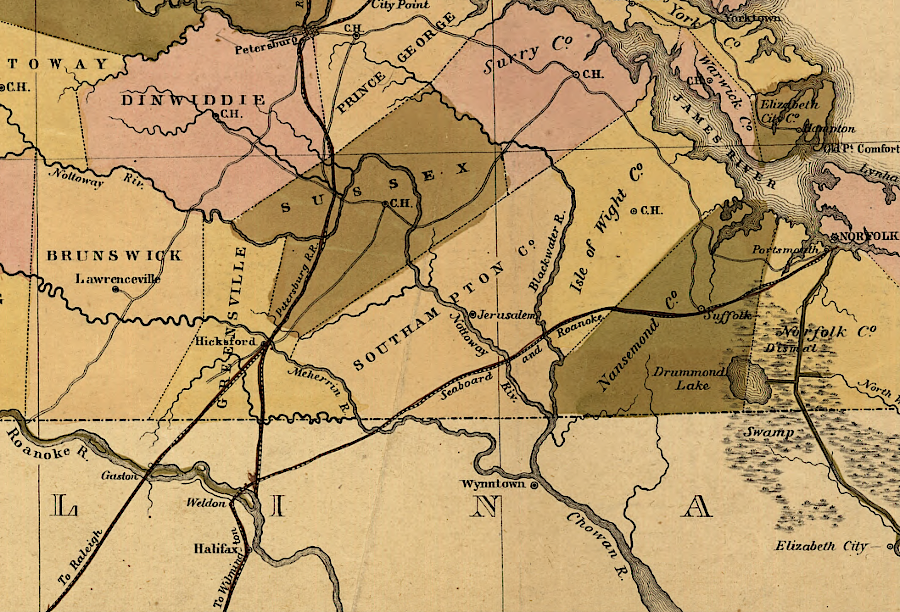
railroads in southern Virginia, 1848
Source: Library of Congress, A map of the internal improvements of Virginia (by Claudius Crozet, 1848)
In 1853, the Raleigh and Gaston Railroad built 16 miles of new track from what is now Old Gaston, North Carolina to Weldon. That freed it from dependence upon the Greensville and Roanoke Railroad. The Weldon connection linked up with the Seaboard and Roanoke Railroad, which could carry passengers and freight to Portsmouth, and the Wilmington and Raleigh (renamed Wilmington and Weldon) Railroad. Traffic from Raleigh could go by rail to two competing port cities in Virginia, plus North Carolina's primary port at Wilmington.
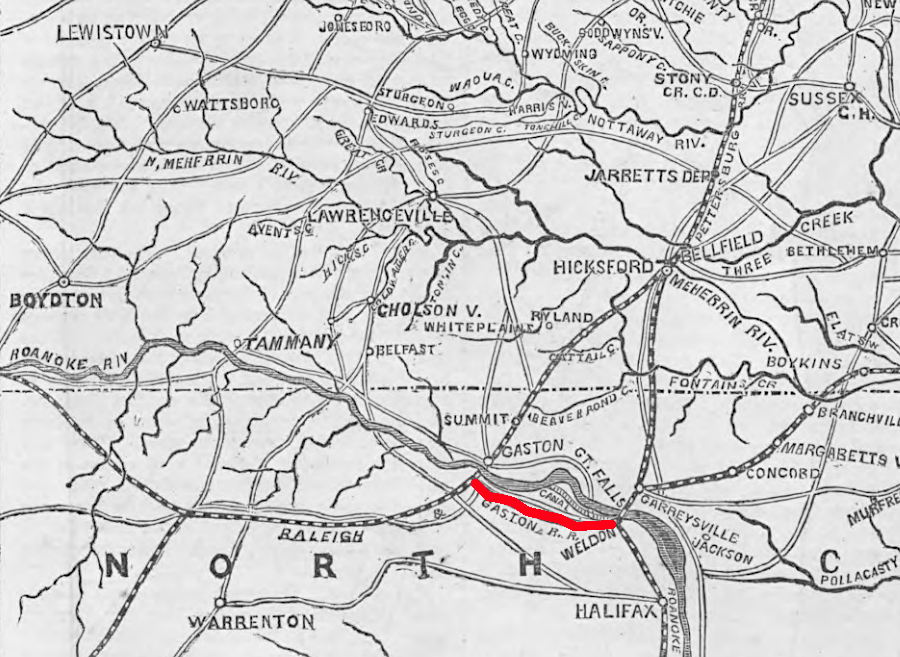
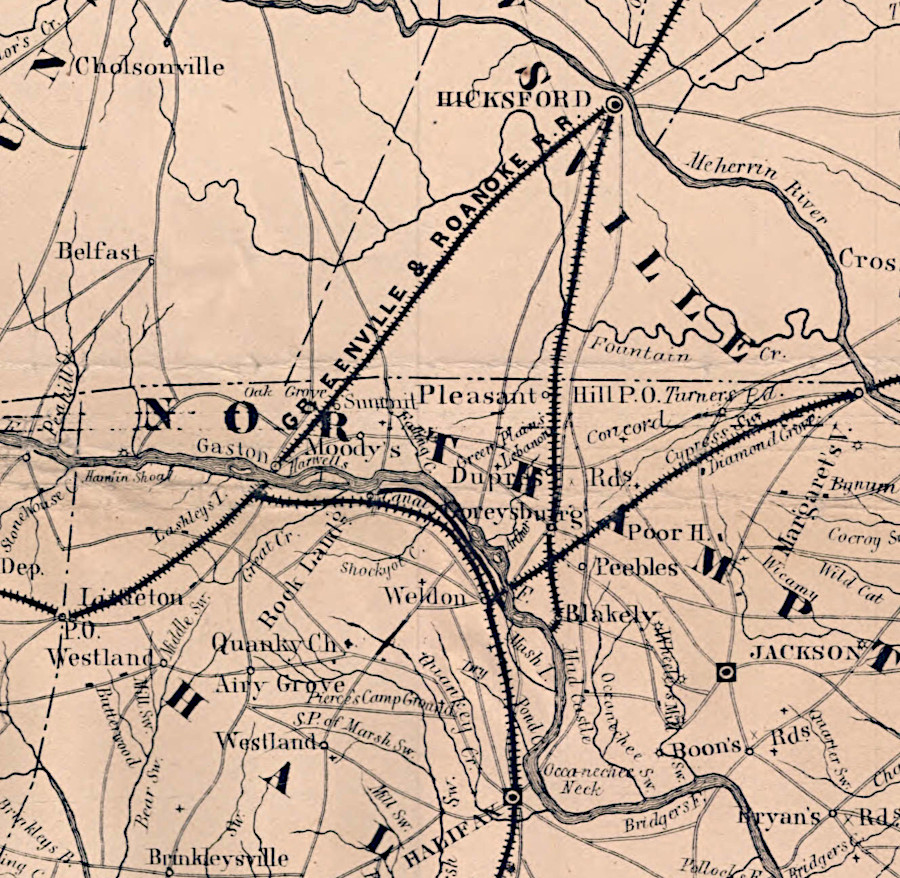
the Raleigh and Gaston Railroad connection to Weldon, completed in 1853, gave it connections beyond just the Greenville and Roanoke Railroad
Source: Harpers Weekly, Map of Virginia Showing the Military Operations of Generals Grant and Butler (May 21, 1864, p.331) and Library of Congress, A map of the internal improvements of Virginia (by Claudius Crozet, 1848)
The Petersburg Railroad's bridge over the Roanoke River was destroyed in the Civil War. It made arrangements to use the Seaboard & Roanoke bridge starting in 1867, interchanging cars at Garysburg. It finally built a new bridge at Weldon in 1910-12.11
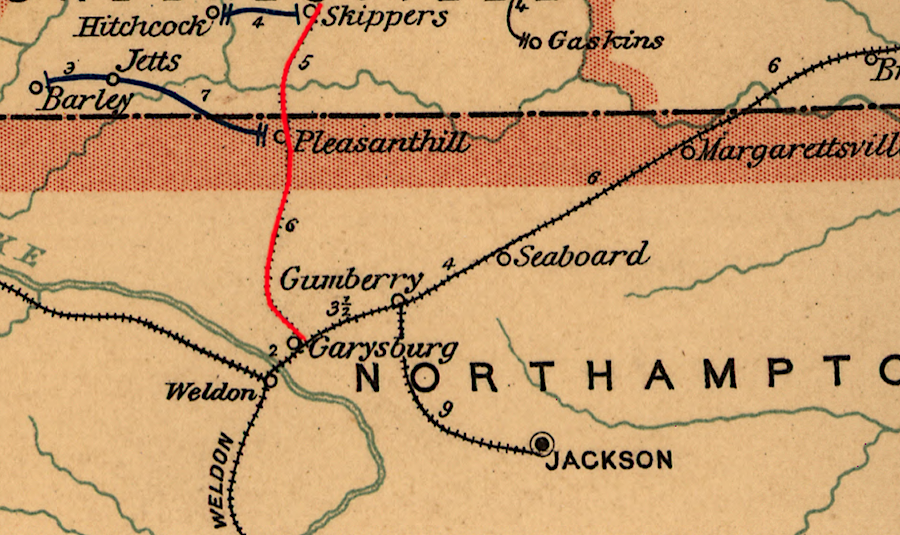
after the Civil War and until 1912, the Petersburg Railroad (red) used the Seaboard & Roanoke bridge over the Roanoke River
Source: Library of Congress, Post route map of the state of Virginia and West Virginia (1896)
During the Civil War, the railroad was a major supply route for the Confederates bringing food and material north to Richmond, and then to the Army of Northern Virginia. Items imported to Wilmington, despite the Union Navy blockade, were transported first by the Wilmington and Weldon Railroad, then by the Petersburg Railroad, and finally by the Richmond and Petersburg Railroad.
The need to increase transportation capacity overcame the desires of the Petersburg City Council to maintain inefficiency within the city, with railroads ending at separate terminals and local jobs increased by using stagecoaches/wagons to carry people and freight between them. Under pressure from the Confederate national government, the City Council authorized connecting the Richmond and Petersburg Railroad, with its terminal on Pocahontas Island, with the Petersburg Railroad.12
During the Civil War, the Petersburg Railroad struggled to replace equipment and repair tracks even before the Union Army finally cut the railroad in 1864 during the Siege of Petersburg. The Superintendent's Office of the railroad notified the president in 1863 that the Confederate Quarter Master's Office and other officials had not been helpful in getting material from Tredegar Iron Works or other sources:13
- I applied to the iron establishment at Richmond for ne[w] RRoad wheels, axles and other irons and was answered that these works were engaged on Government work, and I have not received a new wheel or axle from them during the war. I also applied for a very small quantity of 20 pounds of block tin, in possession of the Ordenance dept but could not get it unless it was to be used for Government work, and I have not been able to get one pound of any metal from the Government, altho as far as I can learn they have secured the Iron of the furnaces of Virginia & I am told by the proprietor of a furnace just gone in operation in North Carolina that the Govt. wish him to use all his iron for cooking utensils for the army.
The siege of Petersburg by the Union Army in 1864-65 focused on cutting off the ability of railroads to bring supplies into Petersburg. In June, 1864, General Ulysses S. Grant launched a cavalry raid to cut the Petersburg, South Side, and Richmond & Danville railroads. The effort by Generals James H. Wilson and August V. Kautz ended at the at the Staunton River Bridge, and disrupted railroad traffic only briefly.
An infantry assault by the Union Army's Second and Sixth Corps on June 22, 1864 stalled short of Globe Tavern. The infantry reached the Jerusalem Plank Road, but failed to get control of what was often called the Weldon Railroad because of its southern terminus. The Confederates continued to use it for another two months.14
On August 18, 1864, Union forces moved west. They reached the Petersburg Railroad and blocked it, in the Battle of the Weldon Railroad (Battle of Globe Tavern). Troops that moved five miles south were forced back when the Confederates won the Battle of Reams Station, but the Confederates could not recapture and reopen the railroad.
Trains coming north from Weldon were forced to stop at Stoney Creek Station. Wagons then carried supplies to Dinwiddie Courthouse, then via the Boydton Plank Road to Petersburg.15
The Petersburg Railroad and the Richmond and Petersburg Railroad merged in 1898 to form the Atlantic Coast Line Railroad Company of Virginia. In 1900, other railroads were added (including the Norfolk & Carolina Railroad, with a terminal on the Elizabeth River) to create the Atlantic Coast Line Railroad.
That major system survived until 1967, when it became part of the Seaboard Coast Line. The old route of the Petersburg Railroad became part of CSX when it absorbed the Seaboard Coast Line in 1983.16
References
1. Charles W. Turner, Charles F. Turner, "The Early Railroad Movement in Virginia," The Virginia Magazine of History and Biography, Volume 55, Number 4 (October, 1947), pp.355-356, https://www.jstor.org/stable/4245511; "Virginia Railroads in 'The Old Dominion State'," American-rails.com, October 9, 2022, https://www.american-rails.com/va.html (last checked October 18, 2021)
2. Peter C. Stewart, "Railroads and Urban Rivalries in Antebellum Eastern Virginia," The Virginia Magazine of History and Biography, Volume 81, Number 1 (January, 1973), pp.5-7, https://www.jstor.org/stable/4247766 (last checked January 20, 2019)
3. Wilson Angley, David Stick, "Inlets," NCpedia, 2006, https://www.ncpedia.org/inlets; James C. Burke, "North Carolina's First Railroads, A Study in Historical Geography," PhD thesis, University of North Carolina at Greensboro, 2008, pp.51-52, https://libres.uncg.edu/ir/uncg/f/Burke_uncg_0154D_10006.pdf (last checked January 16, 2019)
4. Harry McKown, "March 1840: Wilmington & Weldon Railroad," This Month in North Carolina History blog, University of North Carolina Library, March 1, 2006, https://blogs.lib.unc.edu/ncm/index.php/2006/03/01/this_month_march_1840/ (last checked January 20, 2019)
5. People's Press and Wilmington Advertiser, May 14, 1834, in James C. Burke, "North Carolina's First Railroads, A Study in Historical Geography," PhD thesis, University of North Carolina at Greensboro, 2008, p.99, https://libres.uncg.edu/ir/uncg/f/Burke_uncg_0154D_10006.pdf (last checked January 20, 2019)
6. "North Carolina Railroads - Wilmington & Raleigh Railroad," Carolana, http://www.carolana.com/NC/Transportation/railroads/nc_rrs_wilmington_raleigh.html (last checked January 20, 2019)
7. Alan Coleman, "The P&W Supplement to Railroads of North Carolina," http://www.pwrr.org/ncrrs.html; "Greenville and Roanoke Railroad," NCPHS Newsletter, Volume 10, Number 4 (Fall 1991), pp.6-8, http://www.ncpostalhistory.com/wp-content/uploads/2016/05/NCPHS_Journal-038-1991-Fall.pdf; James C. Burke, "North Carolina's First Railroads, A Study in Historical Geography," PhD thesis, University of North Carolina at Greensboro, 2008, pp.51-52, https://libres.uncg.edu/ir/uncg/f/Burke_uncg_0154D_10006.pdf; Ronald E. Shaw, Canals for a Nation: The Canal Era in the United States, 1790-1860, University Press of Kentucky, 1990, p.121, https://books.google.com/books?id=hx2GqYSikMEC (January 16, 2019)
8. "The First Railroad Hub of the South - Weldon NC," Visit Historic Weldon, https://www.historicweldonnc.com/about-weldon-nc/the-first-railroad-hub-of-the-south-weldon-nc.html; James C. Burke, The Wilmington & Raleigh Rail Road Company, 1833-1854, McFarland, 2011, p.163, https://books.google.com/books?id=Bc1dcgpEbZoC (last checked January 18, 2019)
9. "North Carolina Railroads - Greensville & Roanoke Railroad," Carolana, http://www.carolana.com/NC/Transportation/railroads/nc_rrs_greensville_roanoke.html; "North Carolina Railroads - Raleigh & Gaston Railroad," Carolana, http://www.carolana.com/NC/Transportation/railroads/nc_rrs_raleigh_gaston.html; Atlantic Coast Line Railroad," La Belle Woodworking, p.4, https://www.labellemodels.com/manuals/Atlantic%20Coast%20Line.pdf (last checked January 16, 2019)
10. Peter C. Stewart, "Railroads and Urban Rivalries in Antebellum Eastern Virginia," The Virginia Magazine of History and Biography, Volume 81, Number 1 (January, 1973), p.7, https://www.jstor.org/stable/4247766 (last checked January 20, 2019)
11. James C. Burke, The Wilmington & Raleigh Rail Road Company, 1833-1854, McFarland, 2011, p.24, p.134, https://books.google.com/books?id=Bc1dcgpEbZoC; "About Us," Town of Garysburg, North Carolina, https://www.townofgarysburgnc.org/about-us/; Peter C. Stewart, "Railroads and Urban Rivalries in Antebellum Eastern Virginia," The Virginia Magazine of History and Biography, Volume 81, Number 1 (January, 1973), https://www.jstor.org/stable/4247766; Peter C. Stewart, "Railroads and Urban Rivalries in Antebellum Eastern Virginia," The Virginia Magazine of History and Biography, Volume 81, Number 1 (January, 1973), pp.7-9, https://www.jstor.org/stable/4247766; "The First Railroad Hub of the South - Weldon NC," Weldon, North Carolina, https://www.historicweldonnc.com/about-weldon-nc/68-the-first-railroad-hub-of-the-south-weldon-nc.html; "North Carolina Railroads - Raleigh & Gaston Railroad," Carolana, https://www.carolana.com/NC/Transportation/railroads/nc_rrs_raleigh_gaston.html (last checked July 10, 2020)
12. Lou Manarin, ed., Richmond at War: The Minutes of the City Council, 1861 – 1865, in Civil War Richmond, http://www.mdgorman.com/Other_Sites/city_council_minutes,_4_26_1861.htm; "Connecting tracks for the RF&P and Petersburg RRs (running up 8th st) will be completed in a few days," Richmond Whig, August 5, 1861, in "Civil War Richmond," https://www.civilwarrichmond.com/other-sites/railroads/3212-1861-08-05-richmond-whig-connecting-tracks-for-the-rf-p-and-petersburg-rrs-running-up-8th-st-will-be-completed-in-a-few-days; "Railroad up 8th street, connecting RF&P & Petersburg Railroad is nearly complete," Richmond Enquirer, August 10, 2861, in "Civil War Richmond," https://www.civilwarrichmond.com/other-sites/railroads/2331-1861-08-10-richmond-enquirer-railroad-up-8th-street-connecting-rf-p-petersburg-railroad-is-nearly-complete (last checked July 5, 2020)
13. Letter from C. O. Sanford to William T. Joyner, President Petersburg Rail Road, April 4, 1863, in Confederate Railroads, http://www.csa-railroads.com/Essays/Orignial%20Docs/NA/NA,_SWR_4-4-63.htm (last checked August 19, 2020)
14. "Wilson-Kautz Raid," American Battlefield Trust, https://www.battlefields.org/learn/articles/wilson-kautz-raid; Rob Orrison, "The Siege of Petersburg: 'Your Delay Has Been Fatal..." - The First Battle of Weldon Railroad," Emerging Civil War blog, June 24, 2014, https://emergingcivilwar.com/2014/06/24/the-siege-of-petersburg-your-delay-has-been-fatal-the-first-battle-of-weldon-railroad/ (last checked July 6, 2020)
15. Tim Talbott, "Petersburg's Railroads - The Petersburg (Weldon) Railroad," Random Thoughts on History blog, March 22, 2018, http://randomthoughtsonhistory.blogspot.com/2018/03/petersburgs-railroads-petersburg-weldon.html (last checked July 6, 2020)
16. Mike Schafer, Classic American Railroads, Volume 3, MBI Publishing Company, 2003, p.9, https://books.google.com/books?id=MCxgsaXmILcC (last checked December 26, 2018)

the Petersburg Railroad was built to draw Roanoke River trade to Petersburg, competing with the Dismal Swamp Canal taking trade to Norfolk
Source: University of North Carolina, Railroad map of North Carolina (c.1861)
Railroads of Virginia
Virginia Places














